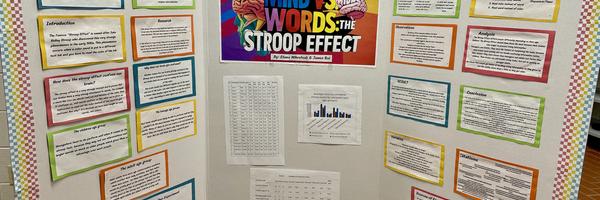Minds vs Words: The stroop effect
Grade 6
Presentation
No video provided
Hypothesis
Our hypothesis is that children (ages 6-12) would perform better than most adults and teenagers because they don’t use large words or use abbreviations a lot.
Research
1.The stroop effect is a very important application of neuroscience, and it can show the decreased attention span to diagnose ADHD and other brain disorders. This task helps diagnose brain disorders by showing a lack of concentration of the participant.
- This effect is a very strange thing and it is very confusing, usually it’ll take longer to say the color of a word than to say the word itself. Basically let’s say we have the word bold but in blue like bold we all would probably say the word first instead of the color but we should really just say the colour according to our tests.
Variables
- Independent Variable (What we change):
- The age group of the participants (Children: 6–12, Teenagers: 13–18, Adults: 24–42, Older Adults: 50–56).
- Dependent Variable (What we measure):
- The time it takes for participants to complete the Stroop tests.
- Controlled Variables (What we keep the same):
- The Stroop task (same set of tests for all participants).
- The method of timing (using the same timer for all participants).
- The number of tests (six tests per participant).
- The number of participants per group (proportionate groups for fair comparison).
Procedure
1. First test: we gave them coloured blocks and asked them to read the colour of the blocks
2. Second test: we had them read normal ink colour words like blue or black.
3. third test: we had participants read words in their own respected colour, for example: green.
4. fourth test: we had the participants read mismatched colour words like: yellow.
5. fifth test: we had everybody in the test read words but in different colours like: bottle.
6. sixth test: we had participants read normal words for an example: fence.
Observations
- The Stroop Effect Impacted Children the Most:
- Children took the longest time, particularly in tasks with mismatched words and colors.
- Their overall slower processing suggests they are more vulnerable to interference.
- Teenagers and Adults Had the Fastest Times:
- Teenagers and adults handled the Stroop tasks with the least difficulty, showing efficient cognitive control and faster resolution of interference.
- Older Adults Were Slower but Still Performed Well:
- Older adults experienced slightly more Stroop interference than younger adults but were faster than children, showing moderate cognitive flexibility.
Analysis
The Stroop Effect affects people differently depending on their age:
- Children: The Stroop Effect slowed them down the most because their brains take longer to process tricky information.
- Teenagers and Adults: They were the fastest at completing the tasks because their brains work quickly and can handle confusing information better.
- Older Adults: They were slower than teenagers and adults but faster than children. Their brains can still handle tricky tasks, but not as quickly as younger adults.
This shows that people get better at handling tricky information as they grow up, but this ability slows down a little as they get older.
Conclusion
- The results of the experiment did not support the hypothesis that children (ages 6–12) would perform better than adults and teenagers on the Stroop tests.
- Children (Aged 6–12): Took the longest time to complete the tasks, especially on the tests with mismatched colors and words. This shows that children struggle more to process tricky or conflicting information, even though they may not use large words or abbreviations often.
- Teenagers (Aged 13–18): Performed better than children, with faster times on all tests. Their brains are more developed, allowing them to process and respond to conflicting information more efficiently.
- Adults (Aged 24–42): Performed the best, with the fastest times overall. Adults have the highest ability to focus and handle interference.
- Older Adults (Aged 50–56): Took slightly longer than teenagers and adults but were still faster than children, showing moderate cognitive abilities.
- The hypothesis that children would perform better than adults and teenagers was incorrect. Instead, the results show that cognitive abilities improve as people grow older, peaking in adulthood, and slightly slowing down in older adulthood. The Stroop Effect is hardest for children because their brains are still developing and are less efficient at ignoring conflicting information.
Application
Sources Of Error
We were testing our participants with a Stroop testing site, but then we realized that we should have tested them differently with a different test to get better results.
Participants may have been distracted by noise or movement, affecting their focus
Participants might have become tired or lost focus during the tests
The number of participants in some age groups (e.g., teenagers) was small.
Differences in reading skill levels, especially among children, could have influenced
Citations
Acknowledgement
We would like to acknowledge these people for their contributions and support for our science project. First my mother for helping us to make our final copy by telling me about her ideas. And second our participants for helping us with our tests we really couldn’t do anything without them. Also we would like to acknowledge all of you and our teacher for making this happen.

